Laos
Things to DO
Luang Prabang
Colour is the first of Luang Prabang's virtues to greet travellers. Pearly frangipanis with their heady
perfume, banks of overgrown trees peppered with scarlet flowers, the burnt sienna robes of hundreds of monks and their novices and
resplendent gold and claret wats.
The scent of fresh coffee, river activity, produce markets and spicy food soon follows. And then the broader aesthetics begin to unfold.
Encircled by mountains, and set 700m above sea level at the confluence of the Nam Khan River and the Mekong River;
Luang Prabang is now Laos' foremost tourist showpiece.
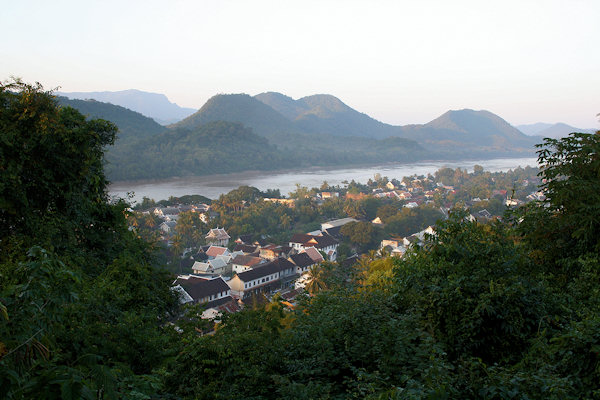 |
|||||
City governors have wisely provided a road bypass sustem that gives the city centre a wide berth. Thus the sense of calm antiquity
that first brought visitirs to the city when Laos opened to tourism in 1989 has been well preserved.
Tak Bat
The word means “giving alms to monks”, so early every morning at dawn, monks go down to the streets, stay in line and get
some food. The residents prepare the food to fill in monk’s bowl. They always give the best food they have because in their idea,
monks deserve the best, and by giving the good food to the monks, they also gave food to their relatives who already died.
All the process happens in silence, everyone participates including the alms givers or tourists who observe the ceremony should
remain in silence during the activity and show respect.
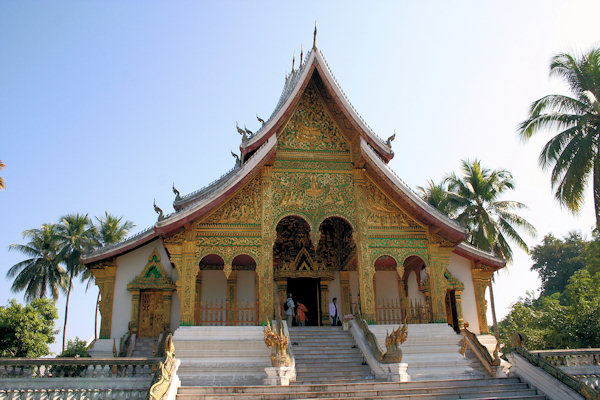 |
|||||
Royal Palace Museum
The palace was built in 1904 during the early French colonial era as a residence for King Sisavang Vong and his family.
The site for the palace was chosen so that official visitors to Luang Prabang could disembark from their river journeys directly
below the palace and be received there.
Architecturally, the building features a blend of traditional Lao motifs and French beaux-arts style, and has been laid out in a
double-cruciform shape with the entrance on one side of the lower crossbar.
The steps leading to the entrance are Italian marble.
Most of the private chambers of the royal family have been preserved since the day the Pathet Lao forced the royals into exile.
Towards the southeastern corner of the compound stands a large, unlabelled bronze statue of King Sisavang Vong
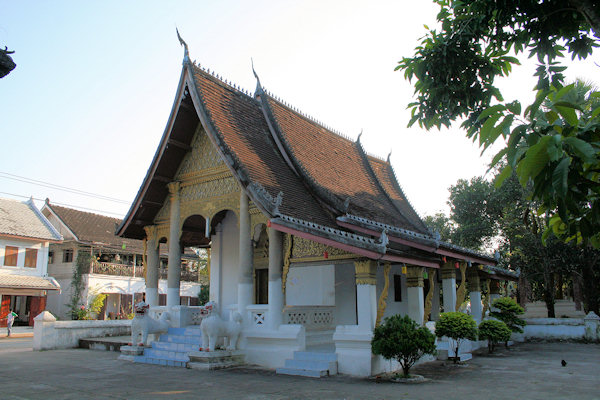 |
|||||
Wandering Luang Prabang's cracked pavements, sweat making me resemble a fried tomato, I spy a Wat, not unusual in itself.
I look it up in my trusty quide book and find it is Wat Srimounkhoun Sayaram; built in 1769 by Phia Kung Mounkhoun.
It looks rather shabby from the outside, but upon approaching it and pausing in the shade of the entrance i am greeting with a hearty
"sabqi-di" from a couple of friendly monks.
Intrigued by this open welcome I ask if it's Okay to wander around. Yes they nod in unison, and usher me in.
As i enter the grounds and turn a corner of one of the buildings, a youngish monk calls to me in Lao. I indicate i can't understand
him and in excellent English he asks where i am from. When i tell him Holland, he get a grin and says "Van Basten".
This and other things you can encounter wandering around in the north eastern corner of town, where there are several active temples.
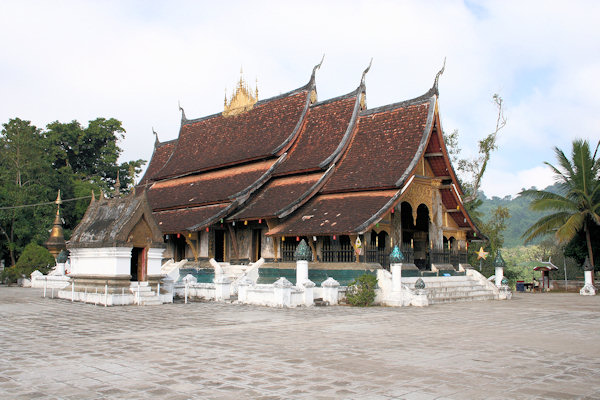 |
|||||
Wat Xieng Thong
King Setthathirat ordered the construction of the "sim" (=ordination hall) in 1560 and the compound remained under
royal patronage until 1975. The sim represents what is considered classic Luang Prabang temple architecture, with roofs that sweep
low to the ground.
Inside, the elaboratly decorated wooden columns support a ceiling stencilled in gold with "dhammachakka" (dharma wheels)
The "haw tai pha sai-nyàat" (=reclining Buddha sanctuary) contains an especially rare reclining Buddha that dates from the
construction of the temple.
This on-of-a-kind figure is exquisitely proportioned in classic Lao style. Insead of merely supporting the head, the unique right-hand
position extends away from the head in a simple but graceful gesture.
The "haw tgi" (Tripitake libary) was added in 1828 and the "haw kawng" (drum tower) in 1961
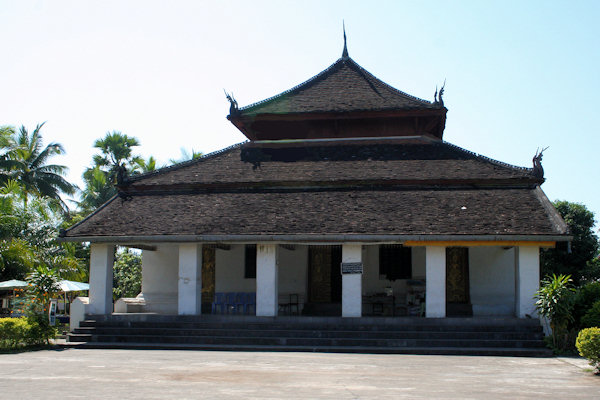 |
|||||
Wat Visunarat
Originally built in 1513 during the reign of Chao Wisunarat (King Visioun) Wat Visunarat is the oldest operating temple
in Luang Prabang. Coursed off a fire it was rebuilt between 1896 and 1898.
The original was wooden and in the brick and stucco restoration the builders tried to make the balustraded window of the
"sim" appear to be fashioned of lathed wood; (an old Khmer contrivance that is uncommon in Laos architecture)
The front roof that slopes sideways over the terrace is another unique feature.
Insight the high-ceilinged "sim" is a collection of gilded wooden "Calling for Rain" Buddhas.
Standing well in front of the "sim" - instead of in the usual spot for a large stupa, immediately behind the
"sim" - stands the 34.5 m
That Pathum (= Lotus Stupa)
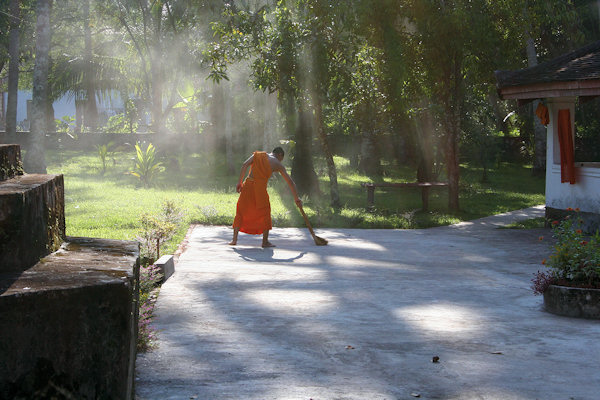 |
|||||
Wat Aham
It is believed that around the 14th century at the site where the Wat Aham currently stands, a shrine was built for Pu No
and Na No, the two guardian spirits of Luang Prabang.
Nearly two centuries later during the reign of King Phothisarath the shrines were destroyed. The King was a devout Buddhist
who worked to end animism and spirit worshipping.
He had the shrines destroyed and built a Buddhist temple on the site, the Wat Aham. When soon after the town of Luang Prabang was
hit by several disasters including diseases, drought and failed harvest, local people believed the destruction of the spirit shrines
to be the cause. During the reign of the next King the shrines were rebuilt.
When the spirit houses were destroyed again in the 20th century, the spirits were believed to have taken residence in the large
banyan trees on the temple grounds. Even today the spirits are remembered during the Laos new year festival celebrations.
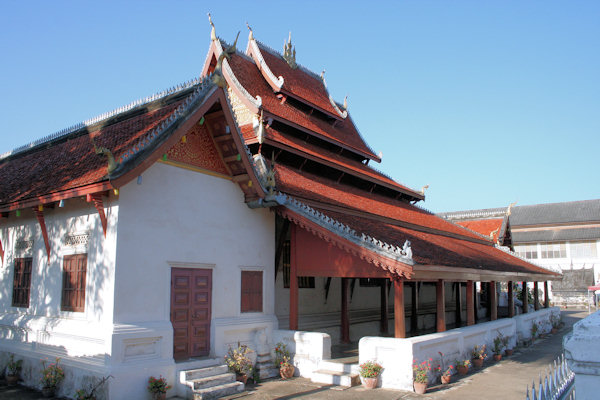 |
|||||
Wat Mai Suwannaphumaham
Inaugurated in 1821 Wat Mai Suwannaphumaham was the residence of the Sangkharat (Supreme Patriarch of Lao Buddhism)
until that position moved to Pha That Luang in Vientiane.
The five-tiered roof of the wooden "sim" follows the standard Luang Prabang style, but the roofed front veranda is
remarkable for its decorated columns and the sumptuous gold relief walls that recount the tale of Vessantara, the
Buddha's penultimate birth, as well as scenes from the Ramayana and village life.
Wat Manolom
Although its outer appearance isn't very impressive Wat Manolom stands just outside the barely visible city walls and occupies
possibly the oldest temple site in Luang Prabang.
City annals say it was founded in 1375 on the site of a smaller temple established by King Fa Ngum.
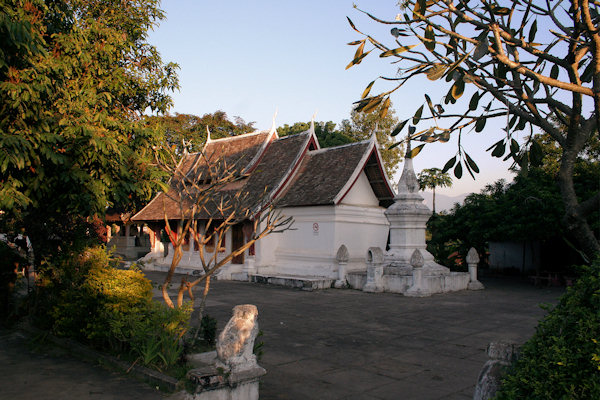 |
|||||
Wat Souvanna Khili
Recently restored, Wat Souvanna Khili was originally built in 1779 by Chao Kham Sattha, a Phuan prince from Xieng Khouang.
A fine example of Luang Prabang III (Xieng Khouang) style, the "sim" features a single nave and porch. Its distinctive
characteristic lies in the addition of a rear hall and posterior stupa.
Wat Si Boun Houang
Built in 1758 during the reign of King Intharavongsa (1749-1768), this Luang Prabang II style temple was restored in the
early 1900s, when some changes were made to its windows and porch.
The wat contains several important Buddha statues which are excellent examples of 18th century Luang Prabang sculpture.
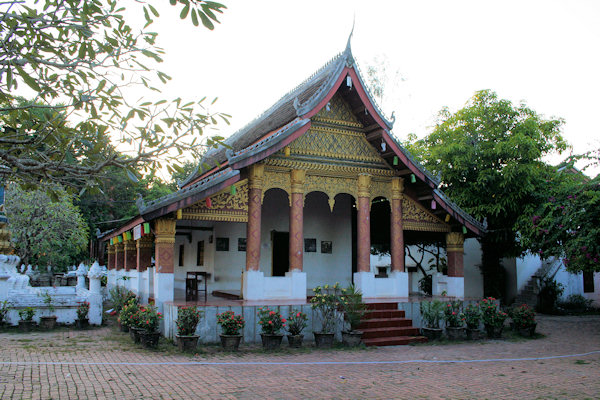 |
|||||
Wat Sop
Wat Sop is said to have been built by King Theng Kham, who reigned from 1479-86, to commemorate the death of his father,
King Sao Takaphat Phene Phao, who reigned from 1438-79. King Sao Takaphat was killed in battle.
Wat Sop has been renovated a few times since then. The sim was expanded in the 1950s with the addition of side peristyles.
Wat Sensoukarahm
This "Temple of the Patriarch" was constructed during the reign of Chao Kingkitsarat (r. 1706-1725), the first ruler
of the independent
Kingdom of Luang Prabang.
Apart from the sim, the monastery includes well over a dozen dwellings that include living quarters for monks, an open pavilion
north of the sim, small Buddha chapels, a drum tower, several stupas, and even a boat shelter.
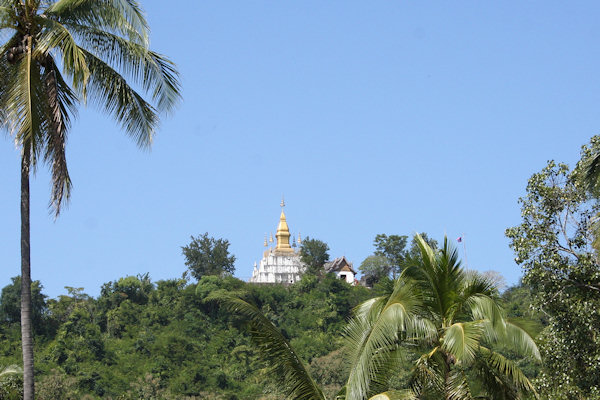 |
|||||
Phu Si
The temples on the upper slopes of 100m high Phu Si were recently constructed, but it is likely there were once other temples
located on this important hill site.
The 24m high That Chomsi erected in 1804 and restored in 1914 stands at the summit clearly visible from most ground/level
points in the city.
This stupa is the starting point for a colourful Lao New Year procession in mid April.
Tat Kuang Si
This beautiful spot (32 km south of town) has a wide, many-tiered waterfall tumbling over limestone formations into series of cool,
turquoise pools. with thick banks of green and florid vegetation on either side, the setting is impossibly picturesque and photogenic.